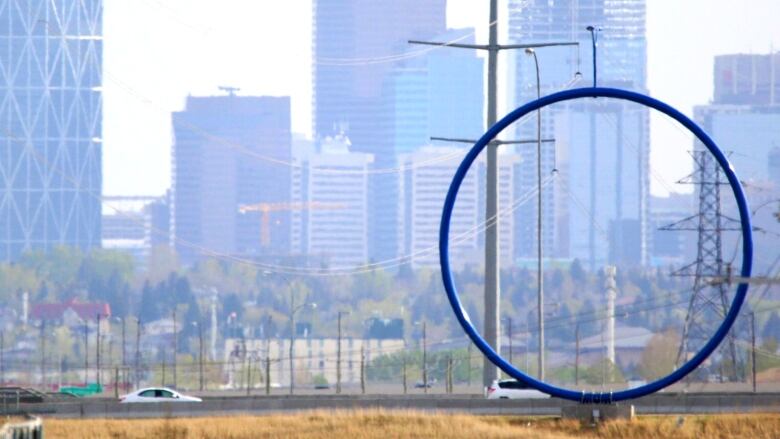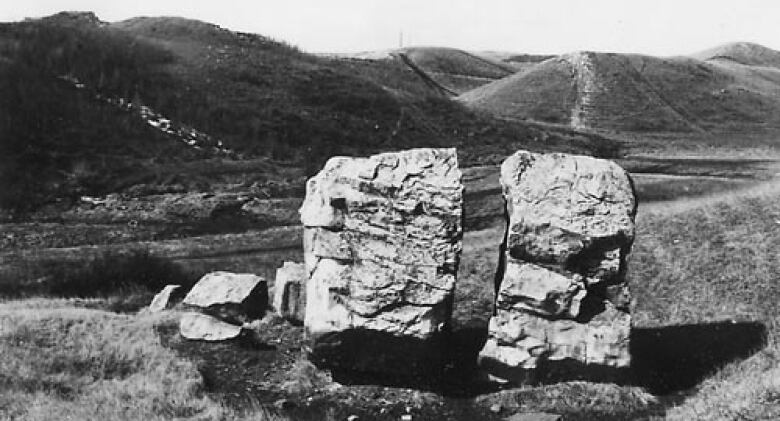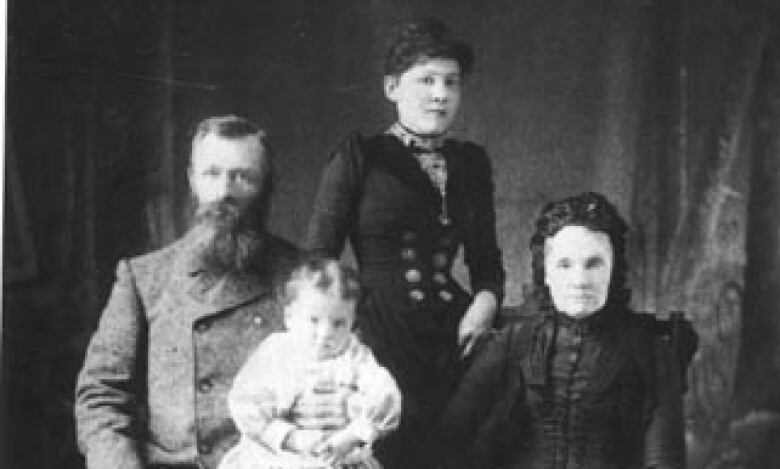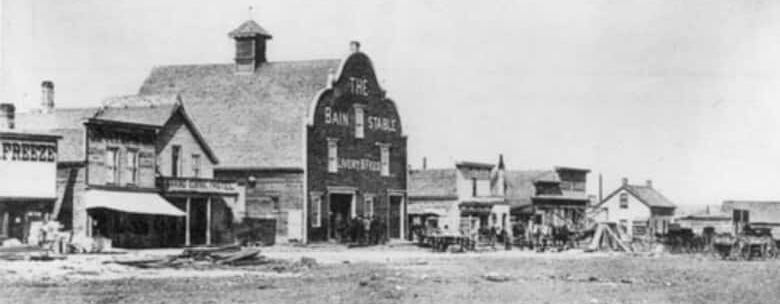The big blue hoop: A lens on Calgary's soul
'Be kind to that blue ring. It means more than we believe it means'

Editor's note:ArithavanHerkis a Calgary writer. Two of herbooks,The Age of Audacity: 50 Years of Ambition and Adventure at Calgary's Own University(a history of the University of Calgary) andStampede and theWestnessof West(a meditation on our annual carnival) will appear this spring.
In 1979, Canadian writerMordecaiRichlerfamously and grumpily commented about Calgary: "That's going to be ahelluvacity when they get it uncrated."
Well, we are well and truly uncrated now, but we cling to a back pocket idea that we are a city so contemporary that the history cupboard is bare.
We're shiny as a copper penny, except of course, those pennies are out of circulation. And we face a different kind of uncrating right now, caught in the throes of this economic contraction.
The shape of our past
When we turn to history, we tend to plunder it for examples of what has happened here before.
We prefer the past to reassure us, and so we enter into a false exchange with its fragments. We read backwards, hunting for other turning points, earlier crises and the solutions they might offer.
We want the past to offer an answer-bandage we can apply to the present. It's hard for us to read history as an active agent, as a dynamic and even enigmatic story that hindsight cannot pin down.
Here, in 21st-century Calgary, we need to be reminded of how our quietly surrounding past is more complicated than dates or famous names, than those who built the highrises or those who made and lost the most money. The danger of using prosperity as a guidepost is how it overshadows the grassroots stories, those closest to our genesis.
We assume public art is there for us to notice and appraise, to love or scorn- Arithavan Herk
We might believe that our character is formed by economics or geology, but there are deeper footings underwriting Calgary, despite our oblivion or our deliberate disregard.
To appreciate Calgary's temperament, to achieve an understanding germane to our quest to become diversified and knowledgeable and self-respecting, we cannot forget how the shape of our past shapes us.
Mapping our magic
Think about Travelling Light, the much-maligned public art lamppost we refer to as the Blue Ring as well as other choice epithets. Calgarians love to hate it, and we make no bones about our dislike.

We assume public art is there for us to notice and appraise, to love or scorn. We overlook the possibility that landscape and art, physical and psychic space in tandem with artistic creation, influence one another. We give magic to magical places, even if we cannot quite map how the transposition happens.
So, think of Travelling Light.
Few know the blue ring's enlarged shadow is visible from outer space. It acts as an inadvertent sundial, and indicates the conjunction of two great glaciers: the Cordilleran ice sheet and the Continental ice sheet, their glacial outwash channels revisiting us in the flood of 2013.
The blue of the ring is the blue of our glacial dreaming, the blue of our yearning, the blue of our cerulean skies, the almost-blue of our current dejection.
Our beginnings
We live in a landscape forged by runoff from glaciation, the Bow and Elbow river valleys glacial outwash channels.
West Nose Creek, which threads its way through our wide northwest valley, was created by the same ice and melt water pushing its way across the prairies and dropping off along the way a few erratic rocks, like the Split Rock in Nose Creek Park.

And hovering over Nose Creek Valley? Travelling Light.
So what, you say? A valley with an erratic doesn't evoke a hula-hoop masquerading as a light post.
But there are places in the world that we remember and that anticipate our remembering.
We humans seek and find meaning in certain physical locations, ground evoking a spirit greater than ordinary. There we connect with the earth's geological eons and we add to its mysteries with our own creations, markers and symbols.
This place, we intuit, holds magic, and so we pay homage. Travelling Light.

We have forgotten that bison grazed the coulees and slopes of Nose Hill and Nose Creek, the main resource for the humans who lived here.
The food, clothing and weapons those animals provided made the fiercely independent and mobile people of the plains rich, an early boom.
Archeological evidence of their sojourns in Nose Creek valley illustrates their civilization.
Above that valley, the blue ring traces the tepee rings that were the first human habitations in this area.
A symbolic circle
When HBC employee Peter Fidler visited Nose Hill with Piikani hosts in December1779, his journal entry records the temperature at a balmy14 C (pay attention, Leo!). The blue ring is a sign of the rollicking Chinook wind, the rushing air currents of our snow eater.
In 1800David Thompson,who had wintered with the Piikani on the Bow River in 1787-1788, made specific note of Nose Hill as a dramatic land feature. There was no blue ring, but the landscape already spoke.
And the weather was not always kind.
When Methodist missionaries George and son John McDougall went bison hunting at Nose Hill in 1876, father Georgegot lost in a blizzard. The snowstorm was so severe no one could go out to search for the missing man until the beginning of February.

They found his frozen body on the east side of Nose Creek on Feb.6, 1876, very close to the blue ring that he might have been reaching for.
And while it is not his literal grave marker, it circles his last breath.
Once the Mounties arrived, followed by the railway, the little settlement of Calgary adopted a mixture of traditions, no fixed structures, which meant not many people adhered to rules.
Blue Ring behaviourstill prevalent. We're never orthodox, and if we can circle a square, we will.
The shape of Calgary
Even if the artists who created Travelling Light had no idea of what their piece reflects, we can, if we think about it, read allegory into its presence, understand how it demonstrates the deep thrum of a history that shapes us as much as we shape it.
Driving north on Deerfoot, it appears as a circle of air, a window or a mirror framing the valley.

Deerfoot Trail is named after the legendary Blackfoot Api-Kai-Ees, the fastest long-distance runner in the west at a time when footraces were a popular competition and the source of much wagering.
In 1886, in a four-day endurance race, he completed a staggering 84 miles over the time allotment of 16 hours, beating all his competitors.
Given the English name Deerfoot, his spirit is acknowledged by the naming of that freeway we all hate to drive.
Glimpsed from Deerfoot, the blue ring commemorates Deerfoot's speed and stamina, even while it expresses our current love of speed, how we all want to win some race.
A city of movement
The blue ring's witness to the airport's flight path only emphasizes the connection to travel, a connection cited when Travelling Light met with so much public derision.
"It essentially represents the universal mode of transportation ... the wheel," said Rachael Seupersad, speaking for Calgary's public art program.
"The artists really looked at the environment and the surrounding area ... it really is a place where all modes of transportation and movement come together and that is sort of captured and symbolized within this piece."
But did the artists know that when the fire of 1886 burned to the ground half of Calgary's wooden buildings, the residents rebuilt with sandstone from stone quarries operating in Nose Creek valley, right under the blue ring's current site?

Sandstone from this area was used in the entrance to the Imperial Bank, the "new" city hall (now our old city hall), James Short School and Calgary's first courthouse.
In the building boom between 1890 and the beginning of World War I, 250 sandstone buildings were constructed; more than half of the city's skilled workmen were stonecutters. That early boom screeched to a bust in 1914.
A congruent economy was provided by bordellos, built along Nose Creek. They contributed to Calgary's reputation, characterized by historian James Gray as the "booze, brotheland gambling capital of the far western plains," a circle of tantalizing ill repute.
Embedded in these stories is the temptation to use history fragments of reality complete with documentation, lies, disputes, and rumour to analyze our present situation.
History is metaphorical and material, concrete and elusive. We think we can decipher the past, and meanwhile, the past interprets us, the blue ring circling Calgary's aspirations, our building mania, our desire to develop, our ubiquitous optimism.

Marker and measure
Be kind to that blue ring. It means more than we believe, and it speaks to our need, especially now, in this troubled and thwarted time, to dream.
We have resisted imbuing it with power, but it resonates with a deeply symbolic vibration, a pulse of momentum, both marker and measure. Here is an icon that declares our presence, our valiant communion with the past, the present, and the future. Let us believe this is a sacred blue circle of hope for our city.
Our character is inscribed by the landscape, by the beauty we take for granted, by our scrabble for survival in a harsh climate, by the drive for community, and by the fact that we had and have a chance, here in the west, to shape a new kind of city and a new perspective, diverse, and venturesome, and enduring.
And whether we like it or not, this blue ring, this "awful" circle, Travelling Light, reflects that vision.
- Public Art:Building Calgary's civic identityone utility box at a time
- ANALYSIS |10 places to find Calgary's unexpected art
Calgary at a Crossroads is CBC Calgary's special focus on life in our city during the downturn. A look at Calgary's culture, identity and what it means to be Calgarian. Read more stories from the series at Calgary at a Crossroads.













_(720p).jpg)


 OFFICIAL HD MUSIC VIDEO.jpg)
.jpg)



























































































